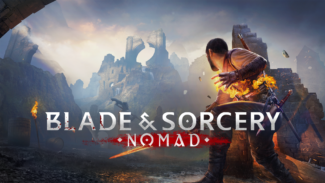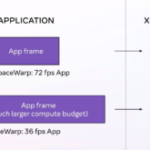Blade And Sorcery’s physics-driven combat is still best-in-class on Quest, but the finished game remains just out of reach. Read on for our Blade And Sorcery: Nomad Review.
Note: Blade And Sorcery: Nomad is technically still an early access release but, given it’s marked as a full game on the Oculus Quest store, it’s getting a full review. We’ll revisit this review once significant updates have been released.
Blade And Sorcery has still got it. Despite nearing its third year in early access, precious few VR games have been able to emulate the sandbox lunacy of its ludicrously enjoyable combat. Where else can you ride a zip line with an axe, barrel into a crowd of dumbfounded combatants and then proceed to kick, slice and fireball your way to victory?
The inevitable Oculus Quest version of the game, Blade And Sorcery: Nomad, still has that bloody magic intact. But, even releasing as a ‘full’ product for the first time on the Oculus Store, it’s clear that Warp Frog’s ode to slapstick slaughter is still a ways out from feeling finished.
If you’ve played Gorn, Boneworks or any other physics-driven VR combat game, you’ll probably know what to expect here. Blade And Sorcery is essentially an extended experiment, searching for more convincing and compelling VR sword fighting. So, rather than frantically waggling your hand around in hopes of success, you need to put real effort and precision into your attacks. Sword swipe didn’t land how you wanted? Then do it once more with feeling. The game simulates the weight of a weapon in that elasticated way, like if you tried to steady your wrist as you pick up a brick with one hand. So a two-handed claymore can’t just be weightlessly waved about; you have to play your part in pretending you’re holding it.
As with similar games, this takes a while to get used to and, as a result, Nomad definitely shouldn’t be your first VR experience. Think of it as something more to graduate to once you’ve warmed up with a few rounds of Superhot.
Once you’ve grown accustomed to that initial strangeness, the real fun can begin. Blade And Sorcery’s combat is, in a word, lethal. Swords can pierce right through enemies with unnerving ease, hatchets have a gruesome knack for embedding themselves in skulls, and magical abilities help augment the carnage in new and often hilarious ways. It’s difficult to overstate just how entertaining this can all be, from dangling opponents from the ankle and then tossing them over the edge of a bridge, to unintentionally decapitating someone and ending up with their head stuck to the end of your sword. This definitely pushes the boundaries of VR violence (and it’s certainly not for the faint of heart), but the dead-eyed, mannequin-like enemies keep you grounded in the humor of it all.
And it is brilliantly silly, at the end of the day. You won’t go two seconds without something unexpected happening, be it losing your grip on a sword as it’s lodged in an enemy’s leg, or accidentally killing someone as you force grip a dagger from across the room. It’s a series of systems clashing with each other in hilarious and incredible ways and, frankly, unlike anything else you’ll find in gaming.
Unwieldy as the combat can be, it’s not just a free-for-all. Well, not quite, at least. Magic attacks let you imbue weapons with new abilities. So a fireball can heat up a blade and penetrate armor, for example, while lightning will make even a slap with the flat side of a sword deal damage. Nevertheless, the game can be unavoidably messy, with enemies jumping straight into the camera and collision mishaps that would send my sword flying off. Good luck rolling the dice on the instant-death platforming sections. Sometimes it’s all part of the fun, sometimes — mainly late into a Survival or Dungeon run — it’s pretty frustrating. This is also the first Oculus Quest 2 game I’ve noticed several performance hitches in, mainly in the form of occasional stutters in larger environments with more enemies.
With that said, the game is definitely a real technical achievement on Quest 2, with some massive areas that stand their ground as you engage in incredibly complex combat. Granted it’s taken a significant hit in the visuals department and you’ll still have less enemies onscreen at once, but it’s pretty clear to see why this needed to be a Quest 2 exclusive.
Currently, Blade And Sorcery is split into two modes: arena-based battling via Sandbox and wave-based Survival modes, or the new Dungeon mode, which introduces a welcome touch of campaign-esque direction through randomized, linear levels. The latter mode is a step in the right direction, giving the game some sense of structure beyond a glorified tech demo, and challenging yourself to reach the end of a Dungeon run is what kept me coming back to the game.
But it’s also true that Blade And Sorcery is in desperate need of more of, well, everything. That goes for simple things like more dungeon environments and weapons, but it also runs deeper than that. The current version is almost feature complete with PC, save for an arena map and some Dungeon rooms, but even with the addition of Dungeons, both versions of the game are still awaiting a progression mode with unlocks and loot that’s set to arrive in 2022. Right now everything’s in ‘Sandbox’ mode, which means you have access to everything and there’s no real rewards for doing pretty much anything in the game.
Without the progression feature, the current version of the game feels more like a toybox that’s fun to play around with but doesn’t have many reasons to keep you coming back. I’d even suggest waiting for that mode so that you haven’t already seen most of what the game has to offer by the time it finally rolls around.
Blade And Sorcery: Nomad Review – Final Impressions
Brutal, heavy and mindlessly satisfying, Blade And Sorcery: Nomad captures the best-in-class, physics-driven combat of the PC version of the game and successfully distills it for Oculus Quest. It’s a messy, lethal playground with endlessly entertaining results that you simply couldn’t get outside of VR. But it’s also true that Nomad — along with the PC VR version — is still two or three updates away from really escaping its tech demo roots, and what’s here now really feels more like a preview both for what the finished product will look like and what other developers could and should do this with groundwork. You’ll have heaps of fun slicing your way through Blade And Sorcery, but its best days are yet to come.
For more on how we arrived at this rating, read our review guidelines. What did you make of our Blade And Sorcery: Nomad review? Let us know in the comments below!







